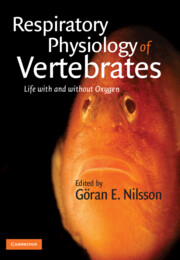Book contents
- Frontmatter
- Contents
- List of contributors
- Preface
- Abbreviations
- Part I General principles
- Part II Special cases
- 5 Adaptations to hypoxia in fishes
- 6 Breathing air in water and in air: the air-breathing fishes
- 7 Air breathers under water: diving mammals and birds
- 8 Vertebrate life at high altitude
- 9 Surviving without any oxygen
- Index
- References
8 - Vertebrate life at high altitude
Published online by Cambridge University Press: 05 June 2012
- Frontmatter
- Contents
- List of contributors
- Preface
- Abbreviations
- Part I General principles
- Part II Special cases
- 5 Adaptations to hypoxia in fishes
- 6 Breathing air in water and in air: the air-breathing fishes
- 7 Air breathers under water: diving mammals and birds
- 8 Vertebrate life at high altitude
- 9 Surviving without any oxygen
- Index
- References
Summary
Introduction
The physiological stresses and limited resources at high altitude pose limits on vertebrate life in this environment. Primary stresses include low oxygen pressure, temperatures, and humidity, and increased radiation. High-altitude ecosystems are characterized by less diversity, rugged topography, and marginal availability of certain nutrients. However, given the amazing physiological abilities to cope with low oxygen described in this book, it is not surprising that there are numerous examples of life at high altitude. Representatives from every class of vertebrates are found living at altitudes of 4000 m above sea level, where the PO2 is less than 100 Torr, including fish (trout) in Andean lakes and rivers (Bouverot et al., 1985). (A pressure of 1 Torr = 1/760 atmosphere = 1 mmHg). The primary focus of this chapter on species that are native to high altitudes is to emphasize adaptations to life with limited oxygen instead of reviewing physiological acclimatization to high altitude. Adaptations to hypoxia in fishes are covered in Chapter 5, so here we focus on air-breathing vertebrates.
The high-altitude environment
Paul Bert first demonstrated that the primary physiological challenge at high altitude is reduced oxygen partial pressure (PO2) as a result of reduced barometric pressure (Bouverot et al.,1985). Various algorithms have been devised to estimate the fall in barometric pressure with altitude, such as the International Civil Aviation Organization (1964) or National Oceanic and Atmospheric Administration (1976) standard atmospheres.
- Type
- Chapter
- Information
- Respiratory Physiology of VertebratesLife With and Without Oxygen, pp. 265 - 299Publisher: Cambridge University PressPrint publication year: 2010
References
- 6
- Cited by

